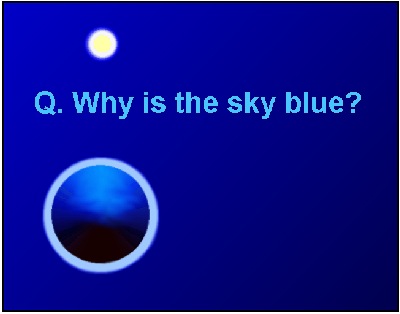
|
seen through our vaporous atmosphere the sky appears blue. The Japanese color wheel said Ultramarine Blue came from Black. "1862, THEORY, The Japanese color wheel was recognized, five colors, White, Yellow, Red, Ultramarine Blue and Black. Yellow came from White, Blue from Black, no Magenta or Cyan. The internal prism spectrum is similar. The apex dark sky color is Ultramarine Blue, an equal mix of transparent Cyan and Magenta pigments. As it gets closer to the horizon the magenta is dropped leaving only cyan as this 2-8-2 NASA photograph shows.
The average color of the sky is from Ultramarine Blue to Cyan Thalo Blue. This color mixture is equal to the pigment Cobalt Blue. Pure Cyan "Phthalocyanine" Blue CYAN tints appear in the lower third of the sky. Magenta and yellow are diminished by atmospheric colloidal vapor. WHY? Seeing more atmosphere toward the horizon line will remove more Magenta from the Ultramarine blue and lighten the sky to Cyan. We can see the effect of the atmospheres color and filter properties in any distant mountain. The light blue translucent vale of atmosphere absorbs color, turning shadow colors into tints of blue and light colors into higher tints with blue added. The shadow color on the closer mountain becomes blue first than the whole mountain with all it's colors, if it's far enough away. This effect starts 10 yards away from you. The artist can see the color shift in that distance and will categorize two to five different concentric plains or rings in each picture. The colors values in each group are not interchangeable. Rule of edges, (excerpt) "It's always darkest next to the light and lightest next to the dark" That goes for the sky next to any object and the object next to the sky too." This is a slight area along the edge, blend it gently to the local color on each side to increase contrast on both sides.
|